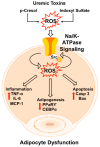Uremic Toxins Activates Na/K-ATPase Oxidant Amplification Loop Causing Phenotypic Changes in Adipocytes in In Vitro Models
- PMID: 30201874
- PMCID: PMC6164729
- DOI: 10.3390/ijms19092685
Uremic Toxins Activates Na/K-ATPase Oxidant Amplification Loop Causing Phenotypic Changes in Adipocytes in In Vitro Models
Abstract
Background: Oxidant stress plays a key role in the development of chronic kidney disease (CKD). Experimental CKD leads to accumulation of uremic toxins (UT) in the circulation resulting in increased ROS production, which in turn, is known to activate the Na/K-ATPase/ROS amplification loop. Studies in a murine model of obesity have shown that increased oxidative stress in plasma is due to increased ROS and cytokine production from dysfunctional adipocytes. Therefore, we hypothesized that adipocytes exposed to UTs will activate the Na/K-ATPase oxidant amplification loop causing redox imbalance and phenotypic alterations in adipocytes. We also aimed to demonstrate that the Na/K-ATPase signaling antagonist, pNaKtide, attenuates these pathophysiological consequences.
Methods: In the first set of experiments, 3T3-L1 murine pre-adipocytes were treated with varying concentrations of UTs, indoxyl sulfate (IS) (50, 100 and 250 µM) and p-cresol (50, 100 and 200 µM), with or without pNaKtide (0.7 µM) for five days in adipogenic media, followed by Oil Red O staining to study adipogenesis. RT-PCR analysis was performed to study expression of adipogenic, apoptotic and inflammatory markers, while DHE staining evaluated the superoxide levels in UT treated cells. In a second set of experiments, visceral fat was obtained from the West Virginian population. MSCs were isolated and cultured in adipogenic media for 14 days, which was treated with indoxyl sulfate (0, 25, 50 and 100 µM) with or without pNaKtide (1 µM). MSC-derived adipocytes were evaluated for morphological and molecular analysis of the above markers.
Results: Our results demonstrated that 3T3-L1 cells and MSCs-derived adipocytes, treated with UTs, exhibited a significant decrease in adipogenesis and apoptosis through activation of the Na/K-ATPase/ROS amplification loop. The treatment with pNaKtide in 3T3-L1 cells and MSC-derived adipocytes negated the effects of UTs and restored cellular redox in adipocytes. We noted a varying effect of pNaKtide, in adipocytes treated with UTs, on inflammatory markers, adipogenic marker and superoxide levels in 3T3-L1 cells and MSC-derived adipocytes.
Conclusions: This study demonstrates for the first time that the Na/K-ATPase/ROS amplification loop activated by elevated levels of UTs has varying effect on phenotypic alterations in adipocytes in various in vitro models. Thus, we propose that, if proven in humans, inhibition of Na/K-ATPase amplification of oxidant stress in CKD patients may ultimately be a novel way to combat adipocyte dysfunction and metabolic imbalance in these patients.
Keywords: CKD; Na/K-ATPase signaling; ROS; adipocytes; oxidative stress; uremic toxins.
Conflict of interest statement
The authors declare no conflict of interest.
Figures







Similar articles
-
Oxidant-Induced Alterations in the Adipocyte Transcriptome: Role of the Na,K-ATPase Oxidant Amplification Loop.Int J Mol Sci. 2020 Aug 18;21(16):5923. doi: 10.3390/ijms21165923. Int J Mol Sci. 2020. PMID: 32824688 Free PMC article.
-
Blockage of the Na-K-ATPase signaling-mediated oxidant amplification loop elongates red blood cell half-life and ameliorates uremic anemia induced by 5/6th PNx in C57BL/6 mice.Am J Physiol Renal Physiol. 2022 Jun 1;322(6):F655-F666. doi: 10.1152/ajprenal.00189.2021. Epub 2022 Apr 18. Am J Physiol Renal Physiol. 2022. PMID: 35435001 Free PMC article.
-
Central Role for Adipocyte Na,K-ATPase Oxidant Amplification Loop in the Pathogenesis of Experimental Uremic Cardiomyopathy.J Am Soc Nephrol. 2020 Aug;31(8):1746-1760. doi: 10.1681/ASN.2019101070. Epub 2020 Jun 25. J Am Soc Nephrol. 2020. Retraction in: J Am Soc Nephrol. 2023 Mar 1;34(3):517-518. doi: 10.1681/ASN.0000000000000051. PMID: 32587074 Free PMC article. Retracted.
-
Phenotypic Alteration of Hepatocytes in Non-Alcoholic Fatty Liver Disease.Int J Med Sci. 2018 Oct 20;15(14):1591-1599. doi: 10.7150/ijms.27953. eCollection 2018. Int J Med Sci. 2018. PMID: 30588181 Free PMC article. Review.
-
The Role of Na/K-ATPase Signaling in Oxidative Stress Related to Obesity and Cardiovascular Disease.Molecules. 2016 Sep 3;21(9):1172. doi: 10.3390/molecules21091172. Molecules. 2016. PMID: 27598118 Free PMC article. Review.
Cited by
-
Adipose tissue metabolic changes in chronic kidney disease.Immunometabolism (Cobham). 2023 Apr 27;5(2):e00023. doi: 10.1097/IN9.0000000000000023. eCollection 2023 Apr. Immunometabolism (Cobham). 2023. PMID: 37128293 Free PMC article. Review.
-
Stimulation of insulin secretion induced by low 4-cresol dose involves the RPS6KA3 signalling pathway.PLoS One. 2024 Oct 24;19(10):e0310370. doi: 10.1371/journal.pone.0310370. eCollection 2024. PLoS One. 2024. PMID: 39446839 Free PMC article.
-
Indoxyl Sulfate Contributes to Adipose Tissue Inflammation through the Activation of NADPH Oxidase.Toxins (Basel). 2020 Aug 5;12(8):502. doi: 10.3390/toxins12080502. Toxins (Basel). 2020. PMID: 32764271 Free PMC article.
-
The potential role of Na-K-ATPase and its signaling in the development of anemia in chronic kidney disease.Am J Physiol Renal Physiol. 2021 Feb 1;320(2):F234-F242. doi: 10.1152/ajprenal.00244.2020. Epub 2020 Dec 28. Am J Physiol Renal Physiol. 2021. PMID: 33356956 Free PMC article. Review.
-
Macrophage and adipocyte interaction as a source of inflammation in kidney disease.Sci Rep. 2021 Feb 3;11(1):2974. doi: 10.1038/s41598-021-82685-4. Sci Rep. 2021. PMID: 33536542 Free PMC article.
References
-
- Modaresi A., Nafar M., Sahraei Z. Oxidative stress in chronic kidney disease. Iran. J. Kidney Dis. 2015;9:165–179. - PubMed
MeSH terms
Substances
Grants and funding
LinkOut - more resources
Full Text Sources
Other Literature Sources

